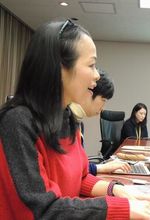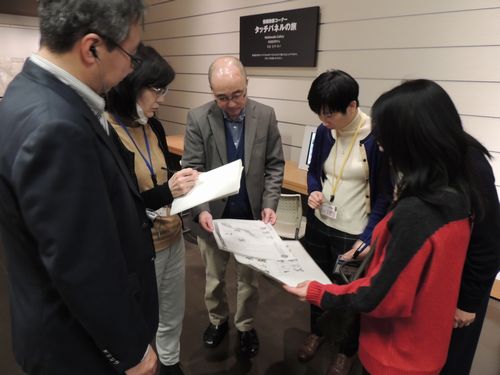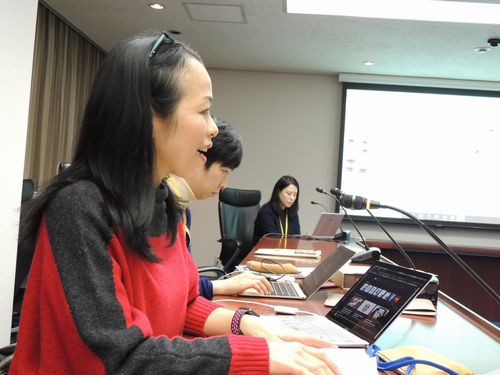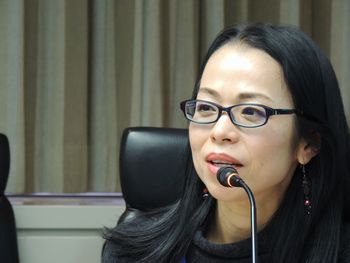Interview with Liberal Arts Communicator! Sachiko Kawai

The National Institutes for the Humanities (NIHU) has been conducting research on human cultures from different angles to pursue harmonious coexistence of individual people as well as that between nature and humans. To that end, we believe it is critical to enhance communications between an actual research site and society.
As part of efforts to enhance such communications, NIHU holds various research exchange events for general public and liberal arts communicators who aim to build “two-way communications.” Who are “liberal arts communicators?” What kinds of activities do they do? We will answer those questions in a series of articles.
The second article is about Dr. Sachiko Kawai, the sixth liberal arts communicator in history, who has just started her job at the NIHU the National Museum for Japanese History in January, 2020. Right upon her arrival, I had a chance to interview her and learn about her enthusiasm and training experience.
I heard that your research topic is women’s and gender history. Please let us know more about it.
Yes, certainly. Let me start with this question -- Have you ever heard of the term, nyoin (女院)? Nyoin is a word that is even unfamiliar to many Japanese people because it is rarely covered in Japanese history textbooks. But if you have studied Japanese history at school, you probably learned insei (院政). During the eleventh through thirteenth centuries, a sovereign who abdicated from the throne wielded influence in political, economic, and religious spheres as a “retired sovereign (in 院),” and this time period is called the era of retired monarchs’ governance. These retired sovereigns, such as Shirakawa-in (1053-1129) or Go-Toba-in (1180-1239), were all male, but in fact their female counterparts, known as nyoin, existed in history.
I specifically explore the power of nyoin who owned many estates (shōen) during the late Heian and early Kamakura periods (c. 1100-1300). It may be surprising that premodern Japanese women were large landholders, but there were quite a few nyoin like that. For example, Sen’yōmon-in (1181-1252) inherited nearly 100 estates at age eleven, and Hachijō-in (1137-1211) accumulated more than 200 estates all over the Japanese archipelago.
I am, however, critical of previous studies that portray nyoin as medieval millionaires due to their large landholdings just because of the size of these women’s portfolios. I argue that it is necessary to examine the gap between authority (socio-politically or legally acknowledged rights) and power (an actual ability to influence or get things done). Although a nyoin held the strongest authority over her estates, it did not automatically guarantee her power to gain material and human resources from these lands. She sometimes faced difficulty in benefitting from her landholdings and protecting them; to successfully manage her estates, she had to strategize.
Indeed, both male and female in faced challenges in managing estates due to such an authority-power gap. In comparison to her male counterparts, however, a nyoin faced more institutional disadvantages that affected her political, economic, and military power. Investigating such a historical phenomenon is important because it helps us realize gender disparity that has persisted for centuries. I believe that history does not justify today or define tomorrow, but through historical studies we can critically perceive our current problems and seek ways to improve.
Historical research tells us another significant thing: power of the weak. Women, like others who were historically disadvantaged or under-represented members of society, were still able to exert influence by navigating through difficulties. In Heian and Kamakura times, some nyoin learned from challenging conditions, pursued solutions, and developed coping abilities. Through my research on individual nyoin and other Japanese women in the past, I would like to share new discoveries with a wider audience and explore the possibility of learning from such historical figures together.
Why did you decide to become a liberal arts communicator?
In different parts of the world today, people are increasingly divided based on their nationalities, ethnic origins, genders, and religious beliefs. In the US, the Trump administration has employed a stricter approach to immigration; Japanese and Korean relations have also been strained. By witnessing such a trend in the world, I began developing a renewed sense of the importance of communicating and understanding with each other.
This was the moment when I saw the job announcement of a liberal arts communicator. I found the job very attractive because of the liberal arts communicator’s role in disseminating exciting information about Japan to a broader audience in both domestic and international settings. I also learned from the announcement that instead of using top-down instruction as a specialist, a liberal arts communicator should aim to reflect feedback from the audience to advance future projects. Additionally, to exchange various types of knowledge and ideas on a global scale, a liberal arts communicator should explain content in a more comprehensive manner and translate it into languages other than Japanese, especially to English.
I also found that my experience living and working as teacher-researcher in the US would enhance my ability to execute the roles assigned to a liberal arts communicator. For almost twenty years I lived in the multi-ethnic city of Los Angeles and taught Japanese history at American universities after obtaining a Ph.D. in History.
Additionally, since my childhood, I have always been interested in exchanging cultures with people overseas and making friends with them. I was excited that I could contribute to connect Japan and the world through this position, so I decided to apply. Now, I am very happy that my past experience and long-held feeling led to my current job as a liberal arts communicator.
Last February, you participated in the skill enhancement training for liberal arts communicators held at the National Museum of Japanese History What did you think of this training?

How was Participating in Hands-on Exhibitions at the Museum’s Exhibition Hall?
The National Museum of Japanese History (Rekihaku) has hands-on exhibitions for children where they can learn different historical and social elements with their friends and families. I tried them by myself during the training. For example, at “Taiken Rekihaku” (Lit. Experiencing Rekihaku) you can learn history through exciting experiences, such as arranging medieval Japanese meals and combining pieces of a Jōmon pottery as if you were an archaeologist. Likewise, “Terakoya Reihaku” (Terakoya Experience Corner) offers an exciting opportunity of experiencing early modern Japanese culture through practicing how to write your own name in cursive writing, figuring out the premodern provincial name for your home prefecture and writing it in cursive, playing sugoroku games, and learning premodern arithmetic methods. It was fun for even a grown-up like me!
Website:https://www.rekihaku.ac.jp/kids/outline/others/experience/index.html

Each Liberal Arts Communicator Answers the Question:How Can We Improve Rekihaku Exhibition and Publicity Activities?
Three liberal arts communicators participated in this training:Kim Satbyulfrom the Research Institute for Humanity and Nature, Mitsuhira Yuki from the International Research Center for Japanese Studies , and me. I was really happy to finally meet other arts communicators!
Dr. Kim and Dr. Mitsuhira presented their wonderful ideas about the ways to improve Rekihaku exhibitions and its publicity by using their own specialties to inspire us. For example, Dr. Kim introduced a project plan to compare Japanese and Korean funeral rituals. Dr. Mitsuhira explained the importance of using an advertising method that appeals to five senses with specific examples. I emphasized that it is important to further incorporate elements concerning women and gender into exhibition materials and to provide multi-language translations. I was happy that I was able to get to know other liberal arts communicators and enhance ties with them. It was a meaningful and enjoyable day.
Finally, I would like to ask you to explain what kinds of activities and research projects you want to do as liberal arts communicator from now on.
Since I became a liberal arts communicator, I have been promoting Rekihaku’s research projects and events by introducing upcoming exhibitions online in English. I have also been translating exhibition panels, Rekihaku’s calendar, and other important announcements to English. Additionally, I am planning to translate the General Magazine of History “Rekihaku” that will be renewed this year and update its back numbers online. Through these efforts, I aim to make “Rekihaku” more accessible and attractive.
In addition, I would like to advance my newly started research on history of premodern Japanese hot springs (onsen). “Wow, how could you change your focus from nyoin to hot springs?”—you might think. The part of the reason was my own love for hot springs, but my nyoin research in fact inspired me to embark upon this topic. When I was studying nyoin, I came across primary sources that were related to bathing and healing cultures in premodern Japan. For example, I found that some nyoin and their acquaintances not only built bathing facilities at their residences but also visited hot springs. According to premodern Japanese sources, royal and aristocratic households had bathing rooms and their calendars included lucky days to take a bath. It is exciting for me to learn what “bathing” meant to Japanese people in the past.
I am currently focusing on premodern Japanese women and hot springs, but this does not mean that I am tied to only this topic; I rather want to examine Japanese people’s relationship with water in a broader sense by investigating related themes such as mineral springs and bathing culture. I am also planning to incorporate perspectives of women’s and gender history into my onsen history research and explore fresh questions.
Lastly, I would like to touch briefly upon a possibility of working with the National Museum of Emerging Science and Innovation. They proposed that I would be participating in their new project focusing on gender. This is a wonderful opportunity through which I could introduce my own research on nyoin and perhaps hot springs. Details have not been decided yet, but I am excited to provide updates in the future.
(Interviewer: Ayumi Hotta)

-Project Researcher (Liberal Arts Communicator) at the Center for Information and Public Relations, National Institutes for the Humanities
-Assistant Professor at the Research Department, National Museum of Japanese History
She received a Ph.D. in History and a Graduate Certificate in Gender Studies at University of Southern California (USC) in May 2015. From 2015 to 2016, she taught at the East Asian Languages and Civilization Department at Harvard University. In the following academic year, she was also at Harvard as the Postdoctoral Fellow at the Edwin O. Reischauer Institute of Japanese Studies. She continued to accumulate her research and teaching experience at USC from 2017-2019, and then she took her position at the National Institutes for the Humanities/ the National Museum of Japanese History.
